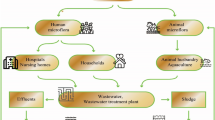Abstract
The resistance to antibiotics which has been increasingly observed in naturally occurringSalmonella panama, is due to an R-factor. A relationship was found between phage pattern and the presence of this R-factor. All strains belonging to phage types A, C and E are sensitive to all antibiotics and are indicated in phage-typing by wild-type phage 47 or host-range mutants of phage 47. All strains belonging to phage types B, D and F possess an R-factor and are indicated by host-modified variants of phage 47. Phage type G, indicated by a host-range mutant, and group Z contain strains with, as well as without an R-factor. Spontaneous drug-sensitive segregants of type B, D and F strains have the phage pattern A, C and E respectively. Conversely, the phage pattern of A, C and E type strains change into B, D and F respectively after infection with the R-factor ofS. panama. The theory can be advanced that type B type A+R-factor, D — C+R-factor and F = E+R-factor. This change in phage type can be considered to be due to the fact that the R-factor exerts restriction and modification of the phage which indicates theS. panama strain without the R-factor.
Many of the antibiotic-resistantEscherichia coli strains found in nature possess an R-factor which can be transferred toS. panama in vitro. Relatively few of these R-factors were found to possess also the restriction marker. Thus up to the present the number ofE. coli strains possessing an R-factor which is able to create a dependable combination of phage type and drug resistance inS. panama is relatively small.
Similar content being viewed by others
References
Anderson, F. S. andFrasir, A. 1955. The influence of the factors determining Vi-type specificity inSalmonella typhi on the adaptation of Vi-phage II. J. gen. Microbiol.13: 519–532.
Anderson, E. S. andFraser, A. 1956. The statistical distribution of phenotypically modifiable particles and host-range mutants in populations of Vi-phage II. J. gen. Microbiol.15: 225–239.
Datta, N. 1965. Infectious drug resistance. Brit. med. Bull.21: 254–259.
Guinfe, P. A. M. 1965. Transfer of multiple drug resistance fromExcherichia coli toSalmonella typhi murium in the mouse intestine. Antonie van Leeuwenhoek31: 314–322.
Guinfe, P. A. M. andScholtens, R. Th. 1967. Phage-typing ofSalmonella panama according to the method of Craigie and Yen. Antonie van Leeuwenhoek33: 25–29.
Lebek, G. 1963. Über die Entstehung mehrfachresistenter Salmonellen. Ein experimenteller Beitrag. Zbl. Bakt., I. Abt. Orig.188: 494–505.
Lizenmifr, G. 1956. Zur Bewertung einer vereinfachten Hemmhofmethode. Zbl. Bakt., I. Abt. Orig.167: 327–328.
Manien, A., Kampilmacher, E. H. andGuinée, P. A. M. 1961a. Frequency of resistance to chloramphenicol and tetracyclines among 12014Salmonella strains isolated in 1958–1959. Antonie van Leeuwenhoek27: 103–109.
Manhn, A., Kamphlmacher, E. H. andGuinée, P. A. M. 1961b. Incidence of resistance to chloramphenicol and tetracyclines among 11981Salmonella strains isolated in 1960. Antonie van Leeuwenhoek27: 461–464.
Manhn, A., Kamphimacher, E. H. andGuinée, P. A. M. 1962. Incidence of resistance to chloramphenicol and tetracyclines among 13502Salmonella strains isolated in 1961. Antonie van Leeuwenhoek28: 428–434.
Manhn, A., Kamphimacher, E. H. andGuinée, P. A. M. 1964. Frequency of resistance to tetracycline and chloramphenicol amongSalmonella strains isolated in the Netherlands in 1962. Antonie van Leeuwenhoek30: 10–16.
Manhn, A., Guinée, P. A. M. andKampilmacher, E. H. 1966. Incidence of resistance to tetracycline and chloramphenicol amongSalmonella bacteria found in The Netherlands in 1963 and 1964. Zbl. Bakt., I. Abt. Orig.200: 13–20.
Miisuhashi, S. 1965. Transmissible drug resistance factor R. Gunmal J. med. Sci.14: 169–209.
Nakaya, R., Nakomura, A. andMurata, Y. 1960. Resistance transfer agents inShigella. Biochem biophys. Res. Commun.3 654–659.
Waianahi, T. andFukasawa, T. 1961. Episome-mediated transfer of drug resistance in Enterobacteriaceae. II. Ehmination of resistance factors with acridine dyes. J. Bact.81: 679–683.
Waianabe, T., Nishida, H., Ogata, C., Arai, T. andSaio, S. 1964. Episome-mediated transfer of drug resistance in enterobacteriaceae. VII. Two types of naturally occurring R-factors. J. Bact.88: 716–726.
Yoshikawa, M. andAkira, T. 1962. Studies on transferable drug resistance in bacteria. IV. Suppression of plaque formation of phages by the resistance factor. Jap. J. Microbiol.6: 121–132.
Author information
Authors and Affiliations
Rights and permissions
About this article
Cite this article
Guinée, P.A.M., Scholtens, R.T. & Willems, H.M.C.C. Influence of resistance-factors on the phage types ofSalmonella Panama . Antonie van Leeuwenhoek 33, 30–40 (1967). https://doi.org/10.1007/BF02045531
Received:
Issue Date:
DOI: https://doi.org/10.1007/BF02045531




